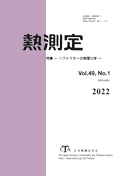巻号一覧

42 巻 (2015)
- 4 号 p. 130-
- 3 号 p. 81-
- 2 号 p. 47-
- 1 号 p. 1-
42 巻, 4 号
選択された号の論文の5件中1~5を表示しています
- |<
- <
- 1
- >
- >|
解説
-
筑紫 格, 西山 枝里, 藤村 順, 横田 麻莉佳2015 年 42 巻 4 号 p. 130-134
発行日: 2015/10/30
公開日: 2022/11/20
ジャーナル フリーWe have developed a top-loading type adiabatic calorimeter with a refrigerator, which works in the temperature range 20–300 K. This calorimeter has following four features, 1) no uses liquid nitrogen and liquid helium for refrigerant, 2) enables us to measure the heat capacities and enthalpy relaxations under stable state for a long time at lower temperature region ( < 77 K: liquid nitrogen temperature), 3) reduces the time required for the sample setup (within ~ 10 min) 4) enables us to set up samples at liquid nitrogen temperature (77 K). The heat capacity of an empty cell was measured in a test experiment. The imprecision of the heat capacity measurement was ±0.8 % at 20–30 K, ±0.4 % at 30–120 K, and ±0.2 % at above 120 K in the present.抄録全体を表示PDF形式でダウンロード (2005K) -
宮崎 州正, 尾澤 岬, 池田 昌司2015 年 42 巻 4 号 p. 135-141
発行日: 2015/10/30
公開日: 2022/11/20
ジャーナル フリーThe nature of the glass transition of supercooled liquids is still surrounded by controversy. The current status of theoretical understanding of the transition is much more like that before the Currie-Weiss theory for critical phenomena in a sense that the full-fledged mean field theory is still not at hand. This, however, does not mean that we suffer from (literally glass-like) stagnancy in the progress. Contrarily, we witness a revolutionary development of the mean-field description of the slow dynamics near the transition escorted by the bona fide thermodynamic transition at a finite temperature. In this review, we start with the introductory discourse of the phenomenology of the glass transition and outline the whole picture of the glass transition which the contemporary version of the mean-field theory envisions. Furthermore, we present the results of our recent numerical study for a randomly pinned liquid, which strongly support the mean-field scenario. This is the first time forever that the true glass state with thermodynamic singularity has been generated in silico.抄録全体を表示PDF形式でダウンロード (1658K) -
辰巳 創一, 上原 拓, 小國 正晴2015 年 42 巻 4 号 p. 142-147
発行日: 2015/10/30
公開日: 2022/11/20
ジャーナル フリーWe found by adiabatic calorimetric and X-ray powder diffraction measurements that cyclohexane confined into pores with a diameter of nm scale exhibits first order phase transition of a new type at 154 K. Emergence of the 1st order transition was restricted only to pores whose diameter was smaller than 3.0 nm, the transition temperature was independent of the pore sizes of confinement, and the transition enthalpy revealed a peak at around the diameter of 2.5 nm. These imply this transition is a liquid-liquid transition. Temperature dependence of X-ray diffraction intensities indicated development of a structural correlation around 0.3 nm at lower temperatures in accompany with the transition: This is consistent with the calorimetric findings.抄録全体を表示PDF形式でダウンロード (1604K) -
一柳 優子2015 年 42 巻 4 号 p. 148-152
発行日: 2015/10/30
公開日: 2022/11/20
ジャーナル フリーWe have proposed magnetic hyperthermia treatment using our magnetic nanoparticles. Hyperthermia treatment is one of cancer therapy using heat effect. Mn-Zn ferrite, Mn1-xZnxFe2O4 nanoparticles encapsulated in amorphous SiO2 were prepared using our original wet chemical method. X-ray diffraction patterns confirmed that the diameters of these particles were within 7–30 nm. Magnetization measurements for various sample compositions revealed that the saturation magnetization (Ms) of 7 nm particles was maximum for the x = 0.2 sample. AC magnetic susceptibility measurements were performed for Mn0.8Zn0.2Fe2O4 (x = 0.2) samples with 13–30 nm particles. The peak of the imaginary part of the magnetic susceptibility χ” shifted to higher temperatures as the particle size increased. From the result of AC magnetic measurements, sample of 18 nm would exhibit highest temperature increase. Measurement system of heating samples by AC field was constructed and observed temperature increase. An AC field was found to cause the increase in highest temperature with the 18 nm particles as expected. Finally, in vitro experiments were carried out to study the hyperthermia effects of Mn1-xZnxFe2O4 (x = 0.2, 18 nm) particles on human cancer cells.抄録全体を表示PDF形式でダウンロード (1439K)
フロギストン
-
2015 年 42 巻 4 号 p. 153-154
発行日: 2015/10/30
公開日: 2022/11/20
ジャーナル フリーPDF形式でダウンロード (662K)
- |<
- <
- 1
- >
- >|